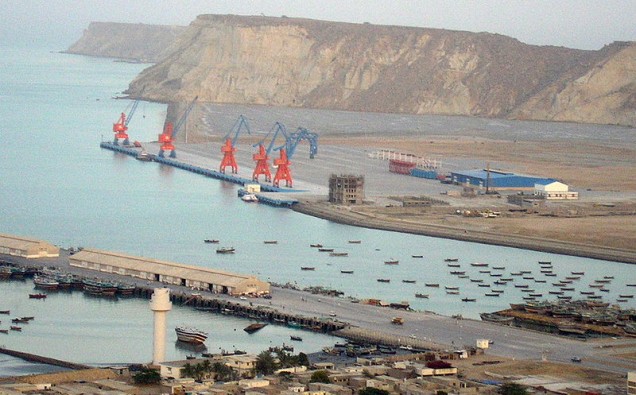
The first trade cargo laden with Chinese export products sailed off to the Middle Eastern destinations and other parts of the world as Gwader deep seaport in the southwestern Pakistan went fully operational with two-way commerce on Sunday.
Prime Minister Nawaz Sharif performed the opening of the immense new trade avenue, a key project under the $46 billion China-Pakistan Economic Corridor (CPEC) that links China’s Xinjiang province with the Arabian Sea through a road that winds through 3000 kilometers across various parts of Pakistan.
Pakistan has a commitment to China’s One Belt-One Road initiative, the prime minister said.
“We will strive for realization of the CPEC and all the projects under its umbrella within the given time,” Sharif said.
“This idea was conceived only two years ago, and this day marks the breaking of the dawn of a new era.”
The CPEC, he said, is for entire Pakistan and no region or province will be left out of it.
The newly-constructed roads in Balochistan have opened up new areas that were earlier inaccessible and deprived millions of development, and resulting economic booms is expected to help bring peace to the volatile region.
The One Belt-One Road project integrates development of various regions, he said, adding that it integrates with Pakistan’s Vision 2025 which seeks to transform Pakistan into a hub of trade and commerce, harnessing its geo-strategic location into a geo-economic advantage.
The corridor of roads, rail lines and highways will help integrate South Asia, China and Central Asia and offer opportunities for people in this region, and investors all over the world, he said.
Director General Inter-Services Public Relations, Pakistan Army,s media wing, Asim Bajwa earlier tweeted that the first mega trade convoy of containers had arrived from China and will be loaded onto ships.
The trade convoy departed from Kashgar, China, on Oct 29, entered Pakistan on Oct 30 and reached Gwadar on Nov 12.
Chinese Ambassador to Pakistan Sun Weidong told the ceremony: “This the first time that a trade convoy successfully passed through the western part of Pakistan from the north to the south. It proves the connectivity of the local roads and the realization of the concept of one corridor with multiple passages.”
“This is the first time that the Gwadar port is exporting containers to overseas destinations. It proves the port has restored it designed handling capacity,” he said. “This is also the first time that Pakistan and China co-organised a trade convoy through Pakistan to Gwadar port.”
Balochistan Chief Minister (CM) Nawab Sanaullah Zehri addressing the ceremony said, “Due to the government’s hectic efforts, the active participation of our security forces and all-out cooperation for the people of Balochistan, we have succeeded in curbing anti-state elements, and the law and order situation has improved.”
Zehri’s claims come a day after a brutal attack on a shrine in Balochistan’s Khuzdar area claimed at least 52 lives and injured over 100 other people.
Top civil and military leadership, including Chief of Army Staff Gen Raheel Sharif, Balochistan Governor Muhammad Khan Achakzai and Balochistan CM Nawab Sanaullah Zehri attended the event.
Executives from Sino Trans, a Chinese logistics company, also attended the ceremony as well as ministers for defence and planning and a number of politicians, especially from Balochistan.
All day long, a stream of trucks of different sizes lined up outside the port to be individually scanned before being ushered in.
The convoys that joined up in Quetta took diverse routes. One convoy came from China, carrying almost 150 containers which were then shifted onto Pakistani trucks at the Sust border crossing south of Khunjerab in the Northern Areas.
Two ships — Al Hussain Zanzibar and Cosco Wellington — are berthed at Gwadar to receive the cargoes. They are setting sail for ports in Bangladesh, Sri Lanka, the UAE and the EU late on Sunday.















